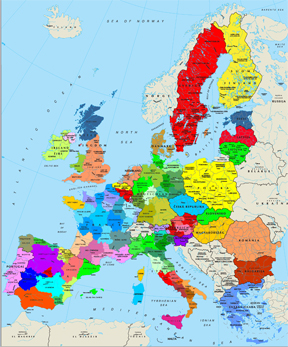By Daniel Nardini

I will not name the professor and the school, but recently I spoke with someone who painted a less than flattering picture of Europe and what it did during the last 300 years. The way this person put it, the European continent was guilty of every thing dirty under the sun from imperialism and swallowing up the rest of the world to ethnic and racial extermination and destroying whole traditional cultures. There is no question that indeed these things happened, but this is only part of the story. There is no question that in the age of European imperial expansion, a lot of dirty and horrid things happened as European rivals carved out a lot of the world in an effort for plundering resources to build their empires and their industrial revolutions. At the same time, the European continent brought out scientific achievements such as ending diseases such as smallpox, helping people even in non-modern countries live longer lives, and building machines such as the train and the modern ship that have done much to revolutionize travel.
The things we take for granted now—such as indoor plumbing, electricity, cars, and the modern skyscraper—all had their origins in Europe. But not just physical improvements have changed the way we live. We must also commend Europe with giving us the concept of rule of law. This and the concept of the right of freedoms guaranteed such as freedom of speech, freedom of the press, freedom of peaceful assembly, and eventually freedom of religion (these ideas may have been put into practice in the United States, but they began long before that in Europe). The very ideas and concepts we call “western” civilization did not exist in Asia, Africa or the American continent before the coming of the Europeans. What I am trying to say is that all continents, and all peoples from whatever continent they may come from, have in one sense or another helped to contribute to humanity as well as have a dark side to them.
No continent is and no single country is the total crucible for good or evil—all peoples and lands have their good and dark sides. To teach one-sided history, and not the basis for the good and bad of any country or continent, is to deny the students of today, and indeed our future generation, the whole picture. But that seems to be happening right now and in too many ways it is getting worse. On the one hand, there are right-wing academics who teach how “perfect” and “wonderful” America and the European continent are and all the wonderful things that have been done. Since the election of U.S. President Barack Obama, both in 2008 and again in 2012, there has been a steady rise of a more left-wing academic block. In this case, these left-wing academics teach of an “evil” and “terrible” imperialist Europe and America bent on world conquest, enslavement of whole peoples, waging war and campaigns of massive destruction, and “destroying” other peoples’ traditional ways of life.
Like the political right, the political left misses the larger picture. But then giving a more balanced picture is not in their cards. This I find troubling, and this will only create a generation unable to see the good for what good there is. It is like the legal racism of the past—people were taught that “separate but equal” was the acceptable norm and that there should indeed be separate bathrooms, separate schools, separate housing, separate drinking fountains, separate places on public transportation, and even separate graveyards. Yet less than two generations ago, a growing number of people asked one of the most basic questions, “if equality and justice is for all, then why must we be separated from each other on the basis of race?” Such people bucked the learning they had received from elementary school all the way through college, and in that sense changed the one-dimensional view that everybody accepted that institutional racism was a “natural” fact of life. So I must ask is it right for those whom we respect to teach one-sided history? Is this not another example of a one-dimensional view?
 Rhapsody Theater Celebrates Cinco de Mayo April 18, 2024
Rhapsody Theater Celebrates Cinco de Mayo April 18, 2024 Earth Day Fun April 18, 2024
Earth Day Fun April 18, 2024 Meeting Challenges Head On April 18, 2024
Meeting Challenges Head On April 18, 2024
 Back of the Yards Holds Vigil Following Tragic Shooting April 18, 2024
Back of the Yards Holds Vigil Following Tragic Shooting April 18, 2024 Auditorium Theatre Announces 2024-25 Season April 18, 2024
Auditorium Theatre Announces 2024-25 Season April 18, 2024






The Unbalanced Academia Curriculum
By Daniel Nardini
I will not name the professor and the school, but recently I spoke with someone who painted a less than flattering picture of Europe and what it did during the last 300 years. The way this person put it, the European continent was guilty of every thing dirty under the sun from imperialism and swallowing up the rest of the world to ethnic and racial extermination and destroying whole traditional cultures. There is no question that indeed these things happened, but this is only part of the story. There is no question that in the age of European imperial expansion, a lot of dirty and horrid things happened as European rivals carved out a lot of the world in an effort for plundering resources to build their empires and their industrial revolutions. At the same time, the European continent brought out scientific achievements such as ending diseases such as smallpox, helping people even in non-modern countries live longer lives, and building machines such as the train and the modern ship that have done much to revolutionize travel.
The things we take for granted now—such as indoor plumbing, electricity, cars, and the modern skyscraper—all had their origins in Europe. But not just physical improvements have changed the way we live. We must also commend Europe with giving us the concept of rule of law. This and the concept of the right of freedoms guaranteed such as freedom of speech, freedom of the press, freedom of peaceful assembly, and eventually freedom of religion (these ideas may have been put into practice in the United States, but they began long before that in Europe). The very ideas and concepts we call “western” civilization did not exist in Asia, Africa or the American continent before the coming of the Europeans. What I am trying to say is that all continents, and all peoples from whatever continent they may come from, have in one sense or another helped to contribute to humanity as well as have a dark side to them.
No continent is and no single country is the total crucible for good or evil—all peoples and lands have their good and dark sides. To teach one-sided history, and not the basis for the good and bad of any country or continent, is to deny the students of today, and indeed our future generation, the whole picture. But that seems to be happening right now and in too many ways it is getting worse. On the one hand, there are right-wing academics who teach how “perfect” and “wonderful” America and the European continent are and all the wonderful things that have been done. Since the election of U.S. President Barack Obama, both in 2008 and again in 2012, there has been a steady rise of a more left-wing academic block. In this case, these left-wing academics teach of an “evil” and “terrible” imperialist Europe and America bent on world conquest, enslavement of whole peoples, waging war and campaigns of massive destruction, and “destroying” other peoples’ traditional ways of life.
Like the political right, the political left misses the larger picture. But then giving a more balanced picture is not in their cards. This I find troubling, and this will only create a generation unable to see the good for what good there is. It is like the legal racism of the past—people were taught that “separate but equal” was the acceptable norm and that there should indeed be separate bathrooms, separate schools, separate housing, separate drinking fountains, separate places on public transportation, and even separate graveyards. Yet less than two generations ago, a growing number of people asked one of the most basic questions, “if equality and justice is for all, then why must we be separated from each other on the basis of race?” Such people bucked the learning they had received from elementary school all the way through college, and in that sense changed the one-dimensional view that everybody accepted that institutional racism was a “natural” fact of life. So I must ask is it right for those whom we respect to teach one-sided history? Is this not another example of a one-dimensional view?